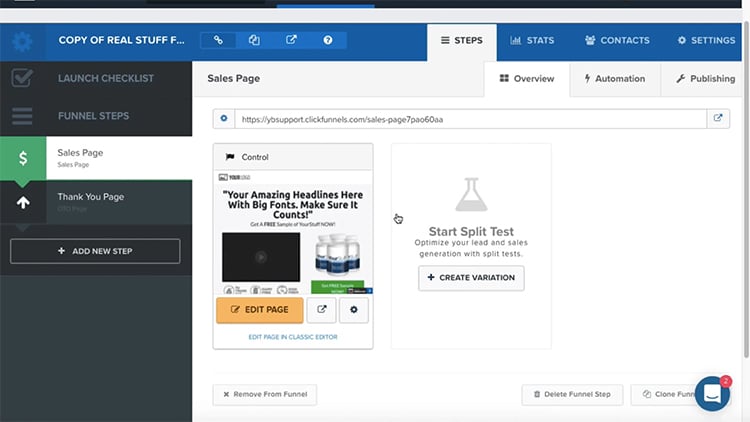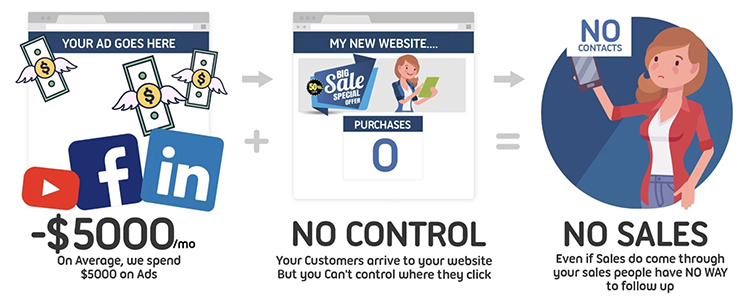The question you’re asking now is the same question you were asking when you started building your business — how do you keep your sales pipeline full? That is, how do you keep increasing brand visibility, generating new promising leads for your business, and even turning those leads into paying customers?
You’ve tried everything — cold emailing, cold calling, even paid ads — but nothing works like you want it to work. Nothing gets you the results your business needs to grow and thrive.
At least, that’s how it feels.
In this article, I’m going to show you …
- What a sales pipeline is
- How to build one that converts like clockwork
- And then, how to keep it full of promising leads
That way, you can get back to building the business of your entrepreneurial dreams.
What is a Sales Pipeline?
A sales pipeline is a visual representation of the steps that a sales rep takes a prospect through, from learning about your business to buying your products or services.
Many people use the terms “sales funnel” and “sales pipeline” interchangeably. But the truth is a sales funnel is for converting prospects on autopilot, with a series of opt-in forms, sales pages, and order forms.
For example…

A sales pipeline, on the other hand, includes one or several salespeople’s personal touch — that is, a salesperson hops in and out during different stages of the sales funnel to help push the prospect along. This personal touch is often necessary with high-ticket products that require heavy consideration and/or negotiation.

It’s important to intentionally craft your sales pipeline based on what will convert the most prospects. While that seems like an obvious truth, unfortunately, 68% of companies have not attempted to measure their sales pipeline.
Additionally, 37% of marketers say the most challenging part of their job is prospecting (i.e. filling their sales pipeline).

Having a sales pipeline in place doesn’t solve everything, but it certainly helps — it can increase the number of leads you generate and improve your close rate.
How to Build Your Sales Pipeline from Scratch
Step 1. Choose Your Goals & KPIs
Why do you want to create a sales pipeline? Your sales pipeline will only be as effective as the clarity you have for why you’re doing it and what your end-goal is.
There are a lot of different reasons to create a sales pipeline — maybe you want to generate more leads, maybe you want to increase your close rate, or maybe you want to have a better qualifying system.
Maybe you want to do all of that.
But, when you try to do everything … you end up doing nothing.
Instead, it’s important to know why you’re creating a sales pipeline so you can put the bulk of your efforts where it really matters for your business. Choose KPIs for your sales pipeline (Key Performance Indicators) and assign those KPIs to different people on your sales-team, giving responsibility for certain metrics to specific people. This will ensure that you (and everyone on your team) know what you’re trying to achieve and you have a measuring stick (KPIs) for determining whether you should be celebrating or iterating.
To help you choose which KPIs you should be measuring, here’s what Databox discovered when they asked sales teams which KPIs are the most important:

Step 2. Leverage Project Management Software
When implementing a new sales pipeline, things can get cluttered and confusing quickly. At least partly fueled by that reality, HubSpot research discovered that 48% of salespeople listed “Improving the efficiency of the sales funnel” and 32% listed “reducing the length of the sales cycle.”

Perhaps the lowest hanging fruit for increasing the efficiency of your sales pipeline is to leverage high-quality, easy-to-use project management software — a place where sales team members can pass leads from one to another, collaborate, and visualize the projects they’re currently tackling.
Trello and Asana are a few of my favorite visual project management tools.
Step 3. Determine The Stages
The second step to building your sales pipeline is to determine each stage that you’re going to guide the prospect through — from a high level and from a more granular practical level.
Take some time to think through everything that the potential client needs to consider before buying from you.
- What are their major concerns?
- What is the ideal number of follow-ups?
- How long does it typically take them to purchase from you?
- Also, how do you want to follow up with prospects — phone calls, emails, texts?
Here’s an example of what your sales pipeline stages might look like and, practically speaking, how you can execute on each…
- Prospecting — How are you going to find prospects? Will you run Facebook ads? Cold email? Cold call? Ask for referrals? All of the above? I’ll provide you with some more additional tips for this part of the sales pipeline at the end of this article.
- Qualifying — How are you going to qualify leads so that your salespeople don’t waste time on the phone with tire kickers? This could be as simple as having a secondary form for when new leads opt-in that asks about income level, decision-making power, and other qualifying factors.
- Proposal — Once you’ve qualified some leads, what will your proposal look like? Will you do it over the phone or via email?
- Follow Up — How many times are you going to follow up with qualified prospects? Some data suggests that you should follow up at least 5 times before calling it quits (even then, you should probably leave them on your general newsletter). Also, how will you follow up? Using text? Calls? Emails? Or a little of everything?
- Close — For those who decide to work with you, what will your closing process look like? Will you just email over the contract? Will you help them through the contract over the phone? At what point do you know someone is ready for you to send over the contract?

Step 4. Create Transitions
When a prospect transitions from one stage of your sales pipeline to the next, how will you communicate that with your team? How will you ensure that prospects don’t get lost in the sales shuffle? How can you polish internal processes and make sure everything runs smoothly?
More than likely, the answer is to get software that allows you to easily organize your sales leads and create smooth pipeline transitions so that everyone knows what to sell, when to sell it, and who to sell it to.
The bigger your sales team, the more necessary this step and the more disorganized things will get if you don’t create seamless transitions between to-dos.
Consider getting CRM software. You can even do some lead-management and follow-up right inside of your ClickFunnels account.
Step 5. Iterate and Optimize Each Stage
No matter how much effort you put in, your first draft won’t be perfect. In fact,— perfect sales pipelines don’t exist. There will always be a chance to learn and improve.
To consistently iterate and optimize your sales pipeline, you need to have a process in place for doing so.
This is a step that you don’t want to leave up to random chance. The winner is often the one who learns and iterates the most consistently and for the longest period of time, so you definitely want to include this as a long-term and fundamental piece of your sales pipeline maintenance.
If you have a ClickFunnels membership (or are considering trying us out), our service includes the ability to split test every piece of your funnel.

How to Keep Your Sales Pipeline Full of Promising Leads (Avoid This BIG Mistake That Most Business Owners Make)
Now we come to the real crux of the issue.
You can build a sales pipeline that’s optimized to convert prospects into paying customers until your eyes bleed, but if you don’t fill the front-end of that pipeline with promising leads, it’s all for not.
After all, the success of your sales pipeline depends on the quantity and quality of the leads which enter that funnel.
So… how are you going to keep your pipeline full of promising leads?
Well, start by not making this common mistake.
Why You Should Stop Sending Paid Traffic to Your Website…
Many entrepreneurs send traffic straight to their website, thinking that people will know where to click and what to buy. In the old days of online marketing, that may have worked just fine. Some of your competitors weren’t even online back then, so having a website was good enough.
But now, people want guidance — B2C prospects and B2B prospects alike.
Whether you’re cold-emailing, cold calling, or running paid ads, don’t send people straight to your website — that’s a big reason that salespeople like you struggle to keep their pipelines full of promising leads…
Your prospects don’t know what to do when they arrive on your website.
Think about it — would you be more likely to make a purchase or take the next step along a company’s sales pipeline if you went to a page like this…

Or if you went to a page like this (assuming you were the target market)…

And it’s not even that the website above is poorly designed or carelessly created, it’s just that… an intentionally crafted sales funnel almost always converts better than a website.
A website is an aimless experience where people can easily browse and just as easily leave, but a sales funnel is like having a salesperson guide the prospect to conversion side-by-side — it’s intentionally crafted to address every objection and to move the prospect forward along the sales pipeline.
It’s the difference between spending $5,000 on ads to land no new clients…

And spending $500 to close 10-15 new clients…

Because even though you can sell your products or services like hotcakes, your website can’t — not like you wish it could, at least. But a sales funnel can.
We’ve witnessed the highest conversion rates in every industry using sales funnels. Heck, that’s how we built ClickFunnels (yep — we drink our own poison).
What Funnel Should You Use to Keep Your Pipeline Full?
How can you stop wasting money on paid ads and start getting a promising ROI on all of that hard-earned cash?
Well… we want to prove to you just how powerful our sales funnel templates can be for your lead-gen efforts. But if you’re still not convinced, check out this case study. And go over here to get your free trial — for 14 days, you can try us out, no strings attached.
Ultimately, keeping your sales pipeline full isn’t a matter of spending more money on paid ads, it’s a matter of sending that paid traffic to the best possible place for conversion (a sales funnel). Once your sales funnel and paid ads are keeping the front end of your sales pipeline filled with promising leads, it’s just a matter of doing what you’ve always rocked at doing — selling your own products or services to those leads over email, text, or through phone calls.
But one thing’s for sure — you can’t push those leads further down the sales pipeline if you don’t acquire them in the first place. And that’s exactly what a sales funnel will help you to do.






Great article. I've been using Clickfunnels for some months now and have seen some great results. Just wanted to thank the team that makes all of it possible. Thanks!